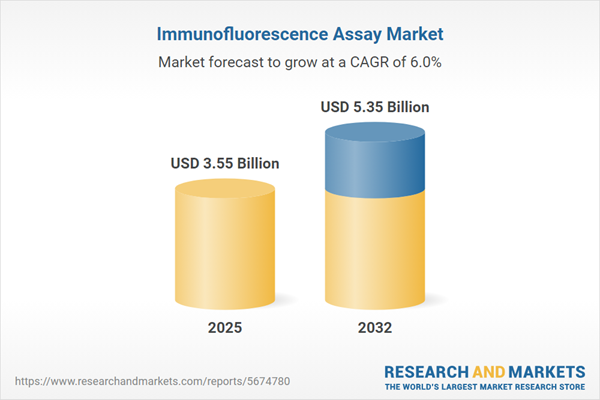Speak directly to the analyst to clarify any post sales queries you may have.
Driven by rapid innovation and evolving clinical standards, the immunofluorescence assay market is entering a phase of significant transformation. Senior leaders in diagnostics, life sciences, and healthcare technology increasingly recognize the need for agile solutions addressing diverse workflow, regulatory, and operational demands.
Immunofluorescence Assay Market Snapshot
The immunofluorescence assay market grew from USD 3.34 billion in 2024 to USD 3.55 billion in 2025. It is projected to continue expanding at a CAGR of 6.03%, reaching USD 5.35 billion by 2032. This momentum reflects broad adoption across diagnostics and research segments, backed by investment in automation, multiplexing, and AI-driven analytics. Shifts in regulatory policy, increasing complexity of clinical diagnostics, and emerging markets also shape demand patterns and supplier strategies in this sector.
Comprehensive Scope & Market Segmentation
This report provides a strategic analysis of the immunofluorescence assay market, outlining its breadth across multiple segments and key global regions. Core segmentation factors include:
- Type of Immunofluorescence: Direct immunofluorescence and indirect immunofluorescence, each supporting diagnostic accuracy and research sensitivity.
- Product: Includes consumables and accessories needed for ongoing assays, instrumentation such as automated analyzers, advanced imaging systems, microscopes for multispectral detection, and reagents & kits tailored to multiplexing needs.
- Application: Spans clinical diagnostics—covering autoimmune disease testing, cancer diagnostics, infectious disease detection—and research & development investigating signaling pathways and novel biomarkers.
- End User: Academic & research institutes, hospitals & diagnostic centers, and pharmaceutical & biotechnology companies, each adapting assay strategies to fit operational and regulatory requirements.
- Geographic Regions: Americas, Europe, Middle East & Africa, and Asia-Pacific, highlighting both mature and high-growth emerging markets.
Company profiles from across the ecosystem are included, such as AAT Bioquest, Agilent Technologies, Bio-Rad Laboratories, and Thermo Fisher Scientific, tracking innovations, partnership strategies, and go-to-market approaches.
Key Takeaways for Senior Decision-Makers
- Adoption of automation and artificial intelligence is streamlining laboratory workflows, reducing manual error, and raising confidence in assay reproducibility for both research and clinical diagnostics.
- Multiplex immunofluorescence enables simultaneous detection of multiple biomarkers, expanding analytical depth and positioning laboratories for greater precision in disease characterization.
- Emerging alliances between instrument manufacturers and digital pathology companies are accelerating the integration of imaging and analytics, while regional expansions enable faster customer support and compliance with local regulations.
- Product innovation is centering around ready-to-use reagent kits, upgraded dye chemistries, and imaging platforms that accommodate high-throughput requirements, directly addressing new operational challenges faced by laboratories globally.
- Regional variability in healthcare infrastructure, regulatory climate, and investment priorities necessitates tailored engagement strategies, with Asia-Pacific and segments of the Middle East & Africa presenting rapid growth opportunities.
- Market leaders are actively pursuing mergers and partnerships to broaden solution portfolios and secure long-term relevance in a changing diagnostics landscape.
Impact of 2025 US Tariff Policies
New tariff measures introduced by the United States in 2025 have significantly affected global immunofluorescence assay supply chains. Higher duties on imported reagents, kits, and specialized equipment have prompted suppliers to reconsider procurement strategies and even explore near-shoring to manage cost volatility. Laboratories are renegotiating contracts, and supply chain resilience is becoming a primary concern, with implications for pricing and long-term operational stability across all markets.
Research Methodology & Data Sources
This analysis utilizes a hybrid approach combining expert interviews with laboratory leaders and comprehensive secondary research from scientific publications, corporate reports, and regulatory filings. Data triangulation and iterative validation with proprietary databases ensure robust, actionable insights suited for real-world application.
Why This Report Matters
- Provides strategic direction for investment in automation and digital pathology, identifying opportunities to streamline operations and sustain competitiveness.
- Enables leaders to anticipate regulatory and market shifts, safeguard supply chain continuity, and allocate resources for responsive innovation.
- Equips stakeholders with actionable segmentation and regional intelligence to prioritize targeted expansion or partnership development initiatives.
Conclusion
As technology, policy, and user requirements evolve, the immunofluorescence assay sector presents notable opportunities for those prepared to adapt. This report delivers comprehensive, practical guidance to support your next phase of strategic planning and market engagement.
Additional Product Information:
- Purchase of this report includes 1 year online access with quarterly updates.
- This report can be updated on request. Please contact our Customer Experience team using the Ask a Question widget on our website.
Table of Contents
3. Executive Summary
4. Market Overview
7. Cumulative Impact of Artificial Intelligence 2025
Companies Mentioned
The companies profiled in this Immunofluorescence Assay market report include:- AAT Bioquest, Inc.
- Abnova Corporation
- AESKU.GROUP GmbH & Co. KG
- Agilent Technologies
- Becton, Dickinson and Company
- Bio-Rad Laboratories, Inc.
- Biocare Medical, LLC
- Bruker Corporation
- Cell Signaling Technology, Inc.
- Cellabs
- Danaher Corporation
- Elabscience Biotechnology Inc.
- Enzo Biochem, Inc.
- F. Hoffmann-La Roche Ltd
- GenScript Biotech Corporation
- J. Mitra & Co. Pvt. Ltd.
- Jackson ImmunoResearch Inc.
- Merck KGaA
- Olympus Corporation
- OriGene Technologies, Inc.
- Proteintech Group
- Rockland Immunochemicals, Inc.
- Santa Cruz Biotechnology, Inc.
- Thermo Fisher Scientific, Inc.
- Vector Laboratories, Inc.
- Zyagen, Inc.
Table Information
| Report Attribute | Details |
|---|---|
| No. of Pages | 184 |
| Published | November 2025 |
| Forecast Period | 2025 - 2032 |
| Estimated Market Value ( USD | $ 3.55 Billion |
| Forecasted Market Value ( USD | $ 5.35 Billion |
| Compound Annual Growth Rate | 6.0% |
| Regions Covered | Global |
| No. of Companies Mentioned | 27 |









